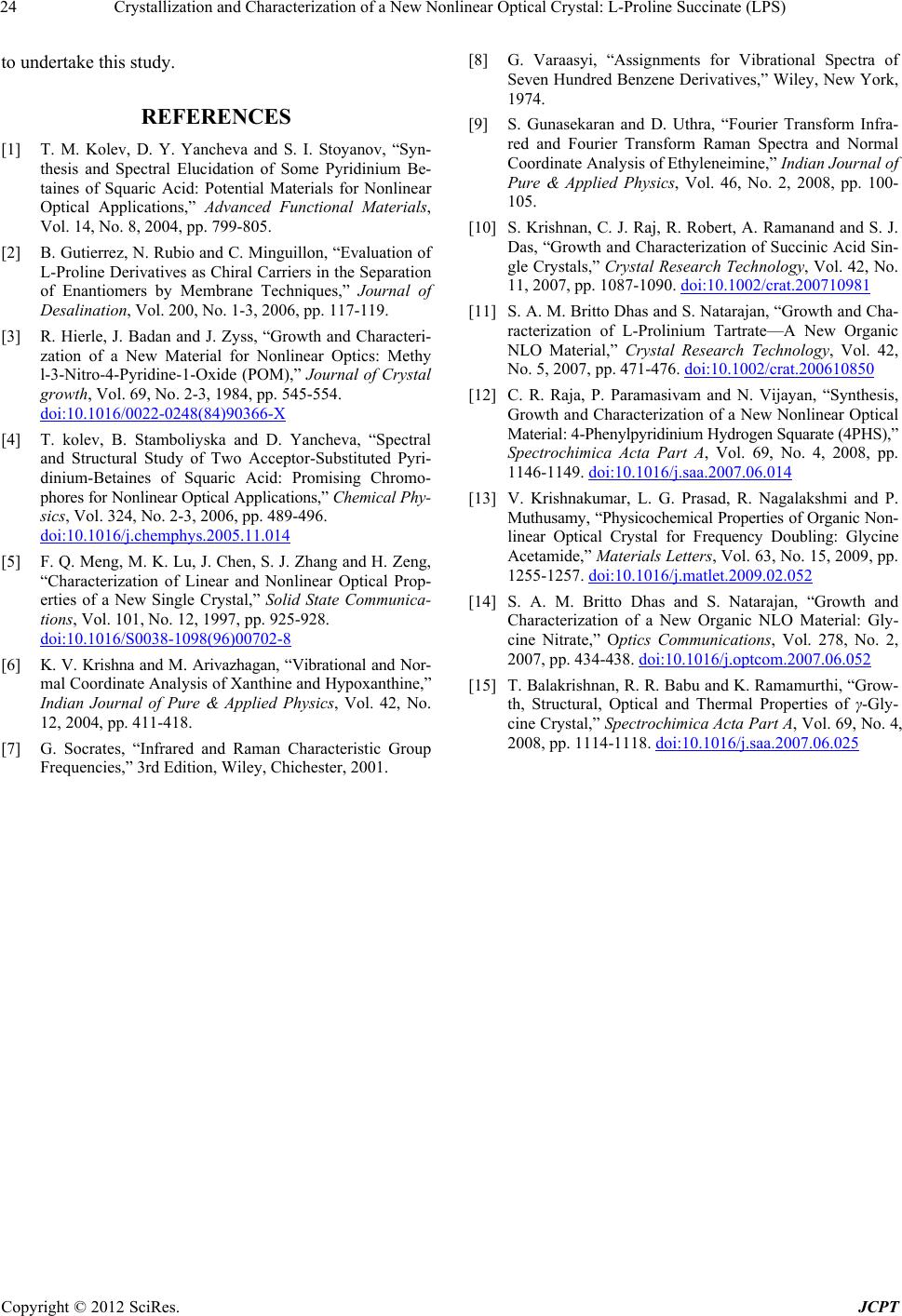
Crystallization and Characterization of a New Nonlinear Optical Crystal: L-Proline Succinate (LPS)
Copyright © 2012 SciRes. JCPT
24
to undertake this study.
REFERENCES
[1] T. M. Kolev, D. Y. Yancheva and S. I. Stoyanov, “Syn-
thesis and Spectral Elucidation of Some Pyridinium Be-
taines of Squaric Acid: Potential Materials for Nonlinear
Optical Applications,” Advanced Functional Materials,
Vol. 14, No. 8, 2004, pp. 799-805.
[2] B. Gutierrez, N. Rubio and C. Minguillon, “Evaluation of
L-Proline Derivatives as Chiral Carriers in the Separation
of Enantiomers by Membrane Techniques,” Journal of
Desalination, Vol. 200, No. 1-3, 2006, pp. 117-119.
[3] R. Hierle, J. Badan and J. Zyss, “Growth and Characteri-
zation of a New Material for Nonlinear Optics: Methy
l-3-Nitro-4-Pyridine-1-Oxide (POM),” Journal of Crystal
growth, Vol. 69, No. 2-3, 1984, pp. 545-554.
doi:10.1016/0022-0248(84)90366-X
[4] T. kolev, B. Stamboliyska and D. Yancheva, “Spectral
and Structural Study of Two Acceptor-Substituted Pyri-
dinium-Betaines of Squaric Acid: Promising Chromo-
phores for Nonlinear Optical App lications,” Chemical Phy-
sics, Vol. 324, No. 2-3, 2006, pp. 489-496.
doi:10.1016/j.chemphys.2005.11.014
[5] F. Q. Meng, M. K. Lu, J. Chen, S. J. Zhang and H. Zeng,
“Characterization of Linear and Nonlinear Optical Prop-
erties of a New Single Crystal,” Solid State Communica-
tions, Vol. 101, No. 12, 1997, pp. 925-928.
doi:10.1016/S0038-1098(96)00702-8
[6] K. V. Krishna and M. Arivazhagan, “Vibrational and Nor-
mal Coordinate Analysis of Xanthine and Hypoxanthine,”
Indian Journal of Pure & Applied Physics, Vol. 42, No.
12, 2004, pp. 411-418.
[7] G. Socrates, “Infrared and Raman Characteristic Group
Frequencies,” 3rd Edition, Wiley, Chichester, 2001.
[8] G. Varaasyi, “Assignments for Vibrational Spectra of
Seven Hundred Benzene Derivatives,” Wiley, New York,
1974.
[9] S. Gunasekaran and D. Uthra, “Fourier Transform Infra-
red and Fourier Transform Raman Spectra and Normal
Coordinate Analysis of Ethyleneimine,” Indian Journal of
Pure & Applied Physics, Vol. 46, No. 2, 2008, pp. 100-
105.
[10] S. Krishnan, C. J. Raj, R. Robert, A. Ramanand and S. J.
Das, “Growth and Charac terization of Succinic Acid Sin-
gle Crystals,” Crystal Research Technology, Vol. 42, No.
11, 2007, pp. 1087-1090. doi:10.1002/crat.200710981
[11] S. A. M. Britto Dhas and S. Natarajan, “Growth and Cha-
racterization of L-Prolinium Tartrate—A New Organic
NLO Material,” Crystal Research Technology, Vol. 42,
No. 5, 2007, pp. 471-476. doi:10.1002/crat.200610850
[12] C. R. Raja, P. Paramasivam and N. Vijayan, “Synthesis,
Growth and Characterization of a New Nonlinear Optical
Material: 4-Phenylpyridinium Hydrogen Squarate (4PHS),”
Spectrochimica Acta Part A, Vol. 69, No. 4, 2008, pp.
1146-1149. doi:10.1016/j.saa.2007.06.014
[13] V. Krishnakumar, L. G. Prasad, R. Nagalakshmi and P.
Muthusamy, “Ph ysicochemical Properties of Organic Non -
linear Optical Crystal for Frequency Doubling: Glycine
Acetamide,” Materials Letters, Vol. 63, No. 15, 2009, pp.
1255-1257. doi:10.1016/j.matlet.2009.02.052
[14] S. A. M. Britto Dhas and S. Natarajan, “Growth and
Characterization of a New Organic NLO Material: Gly-
cine Nitrate,” Optics Communications, Vol. 278, No. 2,
2007, pp. 434-438. doi:10.1016/j.optcom.2007.06.052
[15] T. Balakrishnan, R. R. Babu and K. Ramamurthi, “Grow-
th, Structural, Optical and Thermal Properties of γ-Gly-
cine Crystal,” Spectrochimica Acta Part A, Vol. 69, No. 4,
2008, pp. 1114-1118. doi:10.1016/j.saa.2007.06.025